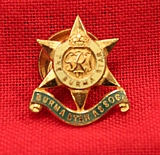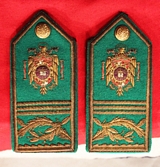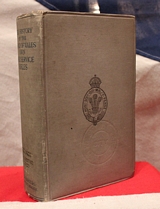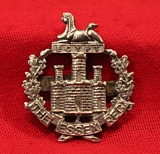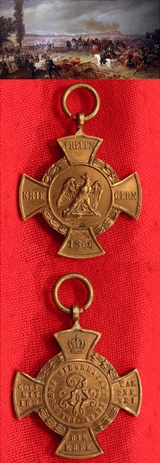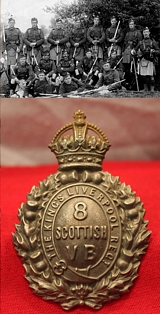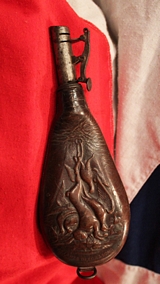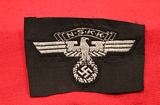WW2 Burma Star Association Lapel Badge
The Burma Star Association was officially founded on the 26 February 1951 with 2,000 founder members. The badge of the Association incorporates a replica of the Burma Campaign Star. Permission to take advantage of this singular honour was supported by His Majesty King George VI in consultation with Earl Mountbatten and Field Marshal Viscount Slim and the badge and title were accepted by the College of Heralds. This fact recognises the rigorous nature of climate, topography and the extremely debilitating conditions in which to wage a successful campaign against a determined and fanatical enemy, thus making this Association unique among post war ex-Service Associations.The first President of the Association was Field Marshal Viscount Slim (Uncle Bill) who held this position until his death on 14 December 1970. read more
15.00 GBP
A Pair of Franco Period Late1930's Spanish Nationalist Officers Epaulettes
On green wool cloth with gilt bullion. read more
95.00 GBP
History of the Prince of Wales Own Civil Service Rifles
Published in 1921 principally the detailed history of the regiment, the men who served and who died in the Great War. The original Westminster City Reference Library copy [offically withdrawn]. A superbly detailed work of one of the famous volunteer regiments of WW1. read more
75.00 GBP
A 1930's Essex Regt. Silver Officers Cap Badge
Essex Regiment Officer?s 1935 silver cap badge. Fine example. Within an oak wreath surmounted by a Sphinx resting on ?Egypt? tablet Castle and Key of Gibraltar, across the base a scroll inscribed ?The Essex Regt?. The Essex Regiment was a line infantry regiment of the British Army in existence from 1881 to 1958, and served in many conflicts such as the Second Boer War and both World War I and World War II, serving with distinction in all three. The regiment was formed in 1881 under the Childers Reforms by the amalgamation of the 44th (East Essex) Regiment of Foot and the 56th (West Essex) Regiment of Foot. read more
120.00 GBP
The Prussian v Austria War Medal 1866, Made From Captured Cannon
Bronze cross patt?e alis?e, a laurel wreath between the arms, with ribbed loop for ribbon suspension; the face with a circular central medallion bearing the cipher ?WR? for King Wilhelm I, circumscribed ?PREUSSENS SIEGREICHEM HEERE? (Prussia?s victorious armies), the Prussian crown on the upper arm of the cross, the left, right and lower arms inscribed ?GOTT WAR MIT UNS. IHM SEI DIE EHRE? (God was with us. To Him be the glory); the reverse with a circular central medallion bearing the crowned Prussian royal eagle perched on a cannon, the upper, left, right and lower arms inscribed ?TREUEN?, KRIE-?, ?GERN?, ?1866? respectively; some slight age oxidisation and wear to gilding; on replaced correct ribbon. The medal was instituted by King Wilhelm I on 20 September 1866 following the victorious war against Austria and its German allies. The medal was cast from the bronze of captured Austrian cannon. The Austro-Prussian War or Seven Weeks' War (also known as the Unification War, Prussian?German War, German Civil War, War of 1866, as well as Brothers War or Fraternal War, and in Germany as German War) was a war fought in 1866 between the German Confederation ("Deutscher Bund") under the leadership of the Austrian Empire ("Kaisertum ?sterreich") and its German allies on one side and the Kingdom of Prussia with its German allies and Italy on the other, that resulted in Prussian dominance over the German states. In the Italian unification process, this is called the Third Independence War.
The major result of the war was a shift in power among the German states away from Austrian and towards Prussian hegemony, and impetus towards the unification of all of the northern German states in a Kleindeutsches Reich that excluded the German Austria. It saw the abolition of the German Confederation and its partial replacement by a North German Confederation ("Norddeutscher Bund") that excluded Austria and the other South German states. The war also resulted in the Italian annexation of the Austrian province of Venetia. read more
85.00 GBP
Prussian Danish War Medal, 1864, Made From Captured Guns
Prussian, Denmark Campaign Medal. 1864 - Engraved Edge. Since the London accords of 1852 the duchies of Schleswig, Holstein and Lauenburg were attached by personal union to Denmark. Following the new constitution of 1863 Denmark integrated these areas into the state which caused a protest from the Deutsche Bund. After a resolution of the German Bundestag the German states send "Execution" troops into the duchies which belonged to the German Federation (Holstein and Lauenburg) under the command of Generalleutnant Heinrich von Hake formed by a Saxon brigade under Generalmajor von Schimpff as the operational-force, a Hanoverian brigade under Generalleutnant Gebser as a supporting force and a Prussian and an Austrian brigade in reserve. The Austrians took part in this Bundesexekutionscorps by sending a brigade under the command of Generalmajor Leopold Graf Gondrecourt. But in addition to this, the two German major powers, Prussia and Austria, decided to declare war on Denmark and sent an army consisting of three corps under the command of the Prussian Feldmarschall Friedrich Graf Wrangel, whose Chief of the General staff was Generalleutnant Eduard Vogel von Falkenstein. The 1st corps was commanded by the Prussian Prince Friedrich Karl, the 2nd corps by Feldmarschall-Leutnant Ludwig Freiherr von Gablenz and the 3rd corps by Generalleutnant von der M?lbe. The 2nd (Austrian) corps was formed by the 6th army corps, enlarged by a cavalry brigade and 2 heavy batteries. Additionally Graf Gondrecourt's brigade also joined the 2nd corps after leaving the surprised federal troops. On the 1st of February 1864 58,000 Prussian and 21.000 Austrian soldiers crossed the Eider and commenced operations against the Danish land forces. On the 2nd and 6th of February the Austrians were victorious at Vejle and Oeversee whilst the Prussians were successful at the D?ppeler Schanzen near Sondersburg on the 18th of April 1864. On the 9th of May a naval squadron commanded by Contre-Admiral Wilhelm von Tegetthoff successfully engaged superior Danish forces near the island of Helgoland. The Danish forces retreated to Northern J?tland and the islands of Alsen and F?nen and an armistice for 6 weeks was agreed for a new peace treaty of London. After the failure of these negotiations the hostilities again resumed on the 25th of June 1864 and the Austrian forces reached the Northern part of J?tland and finally Cape Skagen. The Danish Captain Hammer, who had caused the most trouble for the Austro-Prussian naval forces was captured between the islands of F?hr and Sylt and a new armistice was implemented on the 20th of July 1864 which finally lead to the peace agreement of Vienna on the 30th of October 1864. Denmark was forced to hand over the contested duchies to Prussia and Austria. However disagreement over the administration of these duchies soon became one of the primary reasons, especially promoted by the Prussian prime minister Otto von Bismarck, for the coming conflict between the two German major powers in the war of 1866. Franz Joseph I, Kaiser of Austria, and Wilhelm I, King of Prussia, agreed to institute a commemorative medal for their successful army. The great number of captured guns, especially from the fortress of Frederica, made it possible to decide that the medals should be minted from the brass of the enemy's guns. Kaiser Franz Joseph signed the institution of the medal on the 10th of November 1864 and the regulations (Statuten) dated the 11th of November and both were published in the Armeeverordnungsblatt on the 20th of November 1864. The official name was: "Erinnerungs-Medaille an den Feldzug 1864 gegen D?nemark" (commemorative medal for the 1864 campaign against Denmark) Along the rim of the medal the words: "AUS EROBERTEM GESCHUETZ" (from captured guns) read more
85.00 GBP
8th Scottish Volunteer Battalion Helmet Plate the Kings Liverpool Regiment,
The pre-war territorial Battalions of The King's Liverpool Regiment will also show that the social class within the city was still divided. The King'sLiverpool had six territorial battalions within the city, 5th, 6th, 7th, 8th, 9th, and 10th. The 6th catered for the middle class, 5th, 7th and 9th for the respectable working class, while 8th ( Irish ) and 10th ( Scottish ) recruited men with links to the respected country. the King's Liverpool territorial regiments fought alongside one another many times in France and Belgium in WW1. The battalion was formed on 30th April 1900 when due to the Boer War, it became clear there was a need for men to volunteer their service. It was raised from the higher educated and professional young Scotsmen of city of Liverpool and named the 8th (Scottish) Volunteer Battalion, The King's (Liverpool Regiment). To join you paid an annual subscription of 10 shillings, and an entrance fee of ?2. The first Commanding Officer was Colonel C. Forbes Bell. read more
75.00 GBP
A 19th Century Leather Shot Flask By Renown Maker James Dixon and Son
Embossed leather relief design of hanging game. J Dixon & Sons (James Dixon & Sons) founded 1806 in Sheffield, was one of the major British manufacturers in the Industrial Revolution of the 19th century. They were well known as manufacturers of Pewterware, Electroplated Britannia metal Silverware and Electroplated nickel silver. Their products included hundreds of items for use in the kitchen (e.g. bowls, cutting-tools) and the dining room(e.g. tea services, cocktail shakers and mixers) as well as items like candlesticks for all rooms. They were a world leader in manufacturing shooting accessories through nineteenth century and exported powder flasks in large quantities to America, They were known as whistle makers, which like most of their products were of outstanding quality; they were one of the 4 great whistle makers, the others being W Dowler & Sons, J Stevens & Son & T Yates.
It was located first at Silver Street (1806), Cornish Place (1822) Sheffield . They were also famous for their sporting trophies. Two of the most well-known are the Hales Trophy commissioned in 1932 (sometimes called the Blue Riband) though this really refers to the pendant flown by the sailing ship currently holding the record for the fastest crossing of the Atlantic. The trophy was then held by the owners of that ship. The other great trophy is the one presented to the winner of the American Masters Golf tournament held annually in Augusta Georgia. This trophy is a scale model of the clubhouse made in 1959-60 and contains 453 troy ounces of silver. read more
120.00 GBP
A National Socialist Motor Corps Enlisted Man's Side Cap Eagle Badge
an eagle sitting, its talons gripping a wreath swastika below, with a ribbon banner above inscribed "NSKK", - read more
65.00 GBP


